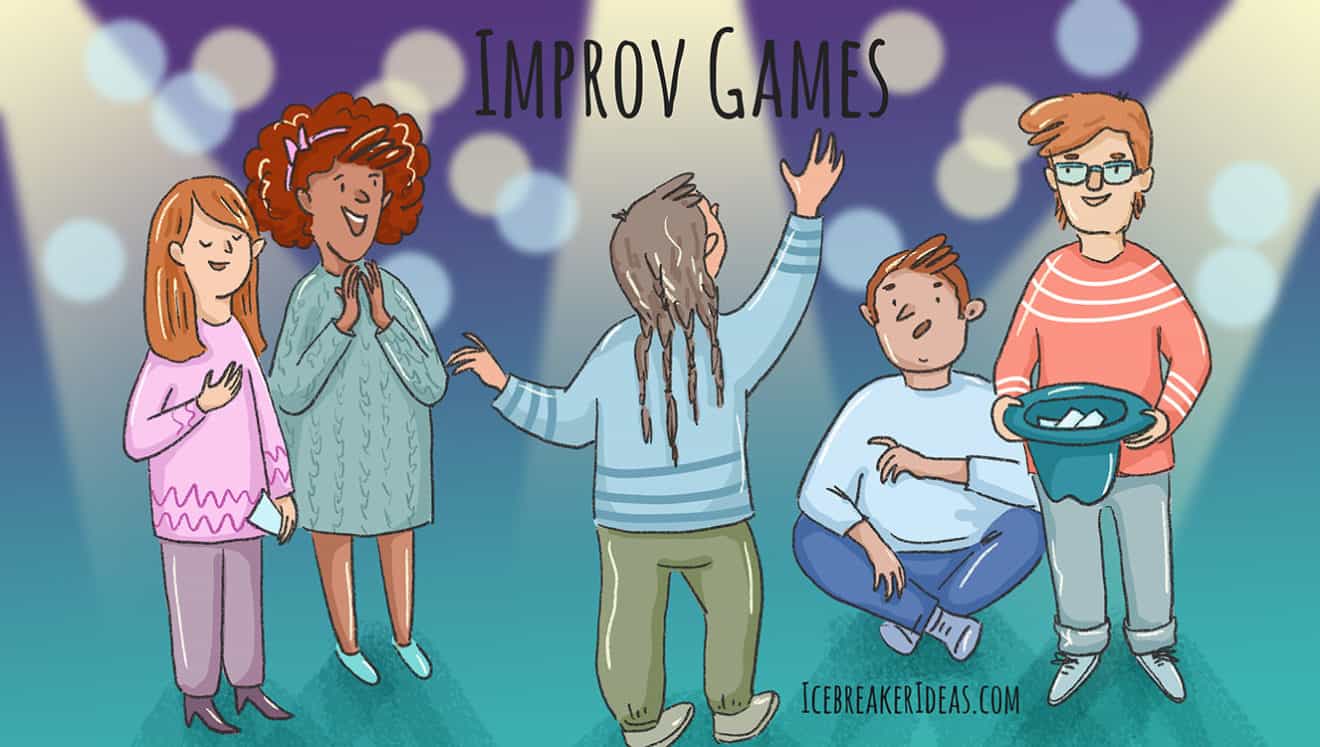Improvisational theater is a form of theater in which all of the actors perform without a script, practice, or even at times, a plot. Everything they do is unscripted, and of course, spontaneous. Watching improvisational theater – simply called improv – can be a load of fun. Needless to say, trying improv first hand can be even more entertaining.
Table of Contents
If you want to recreate those hilarious scenarios from Whose Line is It Anyway, then here are some fun improv games you can try with your class, your friends, or your family.
Dub a Foreign Film
If you were hoping to try a few fun improv games for beginners, this one’s a great start. Give each member of your group a turn to play the role of foreigner or dubber, with four people playing during each round.
How to Play:
- Two of the participants will play the role of foreigners in a film. In a scene where they pretend to have a conversation with one another, these players will speak gibberish and act with exaggerated expressions and hand movements.
- The other two players will dub the scene with lines that they feel would most appropriately fit the first two players’ acting.
- Fun and simple, this hilarious improv game can give you hours of unprecedented laughs. Try to come up with the best scenes and give everyone a chance to play so each person get’s the chances to improve their skills.
Scenes From a Hat
This is a fun improv game idea from the popular 1998 TV show, Whose Line is It Anyway? practices your players’ ability to whip up fun, quirky, entertaining short scenes to challenge their wit and quick thinking.
How to Play:
- To start the game, have everyone think of an idea for an improve scene and write each one down on separate slips of paper. For example, a suggestion might be “the most daring way to quit your job”, or “something you can say that will always start a fight.”
- Have each player come up with 5 or more suggestions and toss them all into a hat. Then, as the game master, pull one out per round and read it out to the players.
- Players should take turns to act out their scene, but there is no structure as to who goes first or last. It all depends on who wants to act out during that scene suggestion. Players who want to pass can skip their turn.
A Word at a Time
If you’re dealing with a group that’s yet to become acquainted, then you might want to start off with a game that isn’t too difficult. A Word at a Time is a great way to warm up your players, giving them an easy yet effective improv experience that will expand their comfort zone so they can take part in the games more willingly.
How to Play:
- To play this game, simply instruct your participants to sit in a circle. The objective is to come up with a cohesive story line.
- To do that, players can only add one word at a time. So you go around the circle, asking each player to add one word to the story as they move along.
- The game ends when you come to a conclusion for your story. So keep on going around the circle to complete your tale and see how funny and outlandish the outcomes can be!
Sound Effects
Here’s an oldie but a goodie. The Sound Effects game is a classic improv game that’s loads of fun and laughs.
How to Play:
- Essentially, players will only be provided the basic idea of the story they’re acting in. It can be anything you can think of, like ‘grandma’s 95th birthday’ or ‘the national clown convention.’
- Tell your participants to incorporate as many actions and invisible props as possible – preferably things that make sounds. And then assign a number of the group to stand by, watch, and make the sound effects for these imaginary props as the story unfolds.
- It can be loads of fun because there are no rules when it comes to providing the sound effects. For instance, a dubber can meow as one of the actors removes a sword from its sheath. There really are no rules – the more unexpected the sound effect, the funnier the scene becomes.
Mystery Box
This one’s a real challenge, making it the perfect game for those who have tried improv before.
How to Play:
- A box containing random objects is placed center stage. Two to five actors are given roles in a general story line. Somewhere down the story, they have to open the box by incorporating it into their tale. For instance, if they’re pretending to be pirates, they can pretend the box is sunken treasure.
- Actors aim to incorporate the random items in the box into their story. What makes it hilarious is that the items in the mystery box are often completely unrelated to the story, but actors are not allowed to pretend the items are anything other than what they are.
- For instance, actors pretending to be in outer space discover underwear in their mystery box. They can’t pretend that the underwear is a flag, a rag, or anything else. They need to incorporate it into the story as it actually is.
News Flash
This fun game adds a touch of wit as players are required to guess what’s on the screen behind them after the whole charade. Two players are designated the role of correspondent while one other participant takes the role of rookie reporter out on the field. The rookie reporter is also the player who gets to make the guess at the end of the game.
- This game requires a projector or a screen playing a random video clip behind the rookie. It starts off with the correspondents reporting a news bit from the ‘news studio’. These players – and the rest of the audience – can see exactly what’s being shown on the video clip.
- They start the report by giving the rookie some clues as to what’s being shown. For instance, in a random clip of baby penguins, the correspondents can say something like, ‘It looks pretty cold down there, rookie!’
- The rookie’s objective is to try to come up with a flash report talking about what’s in the video even if they can’t see what’s being shown. They use cues from the correspondents to come up with an idea as to what clip is playing.
- At the end of the game, the rookie is given the chance to guess what they think was in the clip. If they’re able to formulate an assumption before the game ends and they start reporting on the right topic, then the game is automatically stopped and the rookie wins!
Strange Part Guests
Similar to News Flash, this game involves one player who makes guesses to win the game. There can be as many as 10 players, but for beginners, you might want to involve just 4 others along with the player who makes guesses.
- The mechanics are simple – each ‘party guest’ is given a role. It can be a unique identity or a quirky fictional persona. For instance, one guest will be given the role of The Mad Hatter from Alice in Wonderland, while another plays the role of a hungry hippo inspired by the popular board game.
- No other players should know what the others are pretending to be. The last player is designated the guesser and party, and their objective is to guess what or who all the other players are. They can try to figure that out by talking to each guest at the party.
- To start, each party guest walks into the scene one by one. The party host greets each one at the door. From the moment the guest walks in, all the way to the end of the game, they have to be in character.
- Once the party host figures out who they are, they can call out their guess. If they guessed it right, that party guest gets to leave the party and take a seat with the audience. If not, then the host will have to keep trying. The game ends when the time is up or when the host is able to name each party guest.
Where’s the Remote?
Another fun bit, Where’s the Remote involves five players. Two pairs are designated actors on a TV screen, while the 5th player gets to hold the ‘remote’. To start the game, players are given a list of scenes that they can play out. The 5th player shouldn’t be aware of what theses scenes are.
- The game begins when the 5th player turns on the TV. Each pair of actors takes turns acting out one of the scenes on the list they’re given. They can’t use any sounds and they can’t talk, but they are encouraged to be as expressive with their gestures and movements as possible. The 5th player’s task is to call out what he thinks the players are acting out.
- Once he makes the right guess, he changes the channel and the other pair of actors come on screen, acting out their scene from the list they were given.
- The game goes on like this, with the pairs taking turns whenever the 5th player guesses right and changes the channel. The game ends when all the scenes on the list are finished up.
Props
This fun game challenges the imagination, making it a really fun game for both audience and players. Two teams are given strange props – preferably random foam shapes that don’t really have a particular use. The more obscure the items or shapes, the better.
- The teams are given one different prop each to work with and they take turns coming up with scenes. It can be a hoot especially because the props will often only barely resemble what the actors are trying to use them as.
- Players are also encouraged to use a few phrases to give context to their scene and make it easier for the rest of the audience to figure out what the prop is being used as.
- For example, one pair puts their prop – a big u-shaped piece of foam – on the ground. Both players examine it and one goes, ‘This is the biggest horse I’ve ever seen.’ to clue the audience in that the piece is used to represent a horseshoe print in the scene.
- Teams take turns coming up with random bits using their designated props until the time is up.
Paint Me a Picture
As one of the many fun improv games for kids and adults, pain me a picture starts off slow, with just one player taking center stage. Their objective is to pretend they’re in a specific scenario or environment. This can be anything they want it to be, but it has to be something that everyone is familiar with.
- They act in this environment, performing activities and miming tasks that a person would do in this type of setting. The player can’t speak or make sounds throughout the entire act.
- As the audience watches on and the players start to figure out what the actor is trying to depict in the scene, they can join in and pretend they’re also a part of the environment.
- The game goes on like this, until all of the players figure out what the original environment was. As each one decodes the scene, they join in and become a part of the setting.
- All actors should maintain the environment, avoiding to do anything that would disrupt what’s happening or change the original setting as the first player intended.
Final Thoughts
Improv games can be a load of fun. Challenging your creativity, wit, and humor, you can have hours and hours of laughter with your class, your friends, or your family with this interesting game format. For teachers trying to hone their students’ acting and confidence, then improv games can be instrumental. So don’t forget to pack these games along the next time you’re dealing with your class to help encourage them out of their shells of shyness and make them feel more comfortable just letting loose every now and then.
Susan majored in English with a double minor in Humanities and Business at Arizona State University and earned a Master’s degree in Educational Administration from Liberty University. She taught grades four through twelve in both public and private schools. Subjects included English, U.S. and world history and geography, math, earth and physical science, Bible, information technologies, and creative writing.
Susan has been freelance writing for over ten years, during which time she has written and edited books, newspaper articles, biographies, book reviews, guidelines, neighborhood descriptions for realtors, Power Point presentations, resumes, and numerous other projects.



